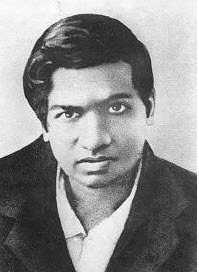Suresh Chandra Sarangi
Robert Kanigel has written a book, “The Man who knew infinity”, depicting the life and work of Srinivasa Ramanujan, the mathematician. The same book was based on a film of the same title produced in 2015 and the role of Srinivas Ramanujan was played by Dev Patel of the ‘Slumdog Millionaire’ fame. In fact, Srinivasa Ramanujan, the quiet and shy individual was a phenomenon and his contribution to mathematics is momentous. Ramanujan was a self-taught mathematician, a prodigy, from Kumbakonam, a town 200 miles away from Madras, who glittered like a pole star and provided guidance to the future generation of mathematicians. It is said, “Life of all great men that reminds us, we can make our life sublime, and departing, leave behind us Footprints on the sands of time.”
Ramanujan was the jewel in the crown and wrote the rules of mathematics in elegant prose that stunned the world. An immaculate and original mathematician who trod the earth like a giant and the beauty of the subject has enthralled many mathematicians and scientists with epochal calculations.
In his childhood, Ramanujan would ask questions that were beyond the senses of most of the students, which established his early mysticism. He would occasionally ask, “What is the distance between two clouds?” such questions baffled everyone. A gifted boy with magical powers to write theorems and also solve them, Ramanujan would continue not only to be known as the wonder boy of mathematics but as the best mathematician, the world has ever produced.

Born in the cantonment area of the Cauvery basin in 1887, Ramanujan grew amidst nature and temples. The river Cauvery, popularly known as Ganga of the South, painted the surrounding vicinity with an intense and utmost green. The edifice of the region’s life, its wealth as well as the spiritual vibration became a solid foundation and instilled a brilliant heritage to the people of the locality. Ramanujan was highly influenced by the cultural landscape, Hindu rituals and spiritual values and the coolness of the temple had a definite impact on him.
Young Ramanujan, lived in a poor but happy Brahmin family living a high Spartan life of grace conspicuous by their simplicity. The ideals of simple living and high thinking were the cornerstone of Ramanujan family. They were sandwiched between two cultural currents, the western liberalism and rational philosophy and the spiritual philosophy of Hinduism.
Ramanujan, the shy, quiet and cool boy of Kumbakonam was influenced by the traditions of temple culture and the Vedic philosophy. His mother who was a singer in the nearest temple had a magical touch that transcended the narrow inhibitions of life and made Ramanujan an inquisitive boy, wondering about nature, numbers and the beautiful grace of mathematics.

Ramanujan’s brilliance was quite outstanding from the earlier days and his intuitive mind was engaged in questioning the teachers regarding the problems and finding a solution to the problems of mathematics by himself. One of the most challenging times was when the math teacher pointed out, “Anything divided by itself was one”, Ramanujan the genius in the asked the question to his teacher, “But is 0/0 also 1? If no fruits are divided among none will each still get 1?” Such was the audacity of mathematical thinking of Ramanujan. Robert Kanigel, writes, “But soon, very soon, that an uneasy balance would be destroyed. Ramanujan would be led out into a new mentally unsettling realm of the intellectual passion and fears of unbending intensity that would rule the rest of his life.” Ramanujan’s intuition baffled almost everybody including his teachers and friends.
He was well-versed in the Vedas, and dwelt upon the concept of God, Zero and Infinity. His mystical powers helped him solve mathematics during his youth which made everyone spellbound. He remained philosophic and was involved in mystical monologues that made him the center of attraction. He was,” immensely devout”, and “intensely religious”, though in the later part of his life, he was influenced by western secular ideas. The south which remained largely untouched by the invaders and cross-cultural currents remained safe behind a shield of mountains, rivers and was quite calm unlike the tumultuous north that instilled inspiration in developing his intuitive power.
A synopsis of elementary results in pure and applied mathematics changed the contours of his life and he wrote his theorems quite naturally. Ramanujan sent his theorems to two British Mathematicians who declined to look into the same. Again he sent it to Thomas Hardy, a brilliant mathematician in Britain, for his blessings. This led to the foundation of a great mathematician’s romance with numbers and the Hardy-Ramanujan combination and metamorphosed mathematics forever. He was a student in Trinity College in Cambridge University and his logical propositions were quite an enigma.

The teachers were disturbed with his elegant questions that led them to ponder over for a solution. But, Ramanujan’s grace in solving them in his sheer power of intuition made him a strong apostle of mathematics and thus he created waves in the mathematics society of Britain and later was included as a member of Royal Society of Mathematics in Great Britain.
The First World War made life miserable in Europe and Ramanujan was walled off in Britain far away from his southern enclave for a long period. Ramanujan theorems were an expression of intuition he managed to present, and later he observed that his powers were derived from the inspiration of the kuladevata, the home-deity of his home.
There is a beautiful story regarding a number, which is known as Ramanujan – Hardy number, ‘1729’, was the number plate of a taxi in which Hardy was moving and he asked Ramanujan that he felt quite disturbed over the numbers. Ramanujan immediately stated ‘1729’ is the natural number following 1728 and preceding 1730. Ramanujan replied that it is a very interesting number; expressible as the sum of two cubes in 2 different ways. The 2 different ways are: 1729 = 13 + 123 = 93 + 103

Ramanujan after getting infected with tuberculosis, returned to India, a hero who dazzled in the European world but remained an unsung person in his native place that is India, as he succumbed to his disease at the prime age of 32. That was not the time of the internet, e-mails, social media, Facebook or twitter, nor even an era where Xerox copies were available.
Ramanujan could not publish his theorems in a book, but his note was retrieved in the form of three notebooks beautifully handwritten and now preserved in Madras library which shows the beauty and grace of mathematics and the special ability of Ramanujan to the entire world. Today after celebrating his 100th birth anniversary, even the world fails to solve his problems. His theorems are being applied in areas like polymer chemistry, computers and even in the treatment of cancer.
This was beyond the imagination of anybody during his lifetime and Ramanujan’s theorems remain to be explored more and more and its utility to be proved further in solving the problems of the world. Life of the genius had a sorrowful end but the pristine beauty of Kumbakonam river beds had started the sheer romance with mathematics.
(Suresh Chandra Sarangi is former General Manager, Bank of India, and lives in Bhubaneswar. Views are personal)
#SrinivasaRamanujan #Mathematics #Mathematician #SlumdogMillionaire #Kumbakonamriver




























